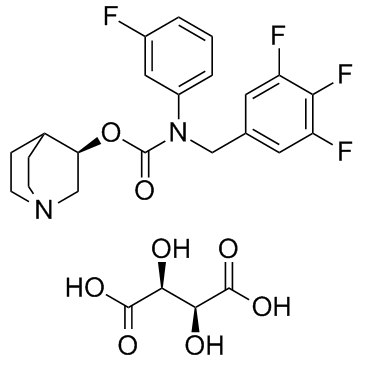Tarafenacin (D-tartrate)
Modify Date: 2025-08-23 22:26:52

Tarafenacin (D-tartrate) structure
|
Common Name | Tarafenacin (D-tartrate) | ||
|---|---|---|---|---|
| CAS Number | 1159101-48-0 | Molecular Weight | 558.47600 | |
| Density | N/A | Boiling Point | N/A | |
| Molecular Formula | C25H26F4N2O8 | Melting Point | N/A | |
| MSDS | N/A | Flash Point | N/A | |
Use of Tarafenacin (D-tartrate)Tarafenacin(SVT-40776) is a highly selective M3 muscarinic receptor antagonist (Ki= 0.19 nM), ~200 fold selectivity over M2 receptor.IC50 value: 0.19 nM (Ki) [1]Target: M3 muscarinic receptorin vitro: SVT-40776 is highly selective for M(3) over M(2) receptors (Ki = 0.19 nmol.L(-1) for M(3) receptor affinity). SVT-40776 was the most potent in inhibiting carbachol-induced bladder contractions of the anti-cholinergic agents tested, without affecting atrial contractions over the same range of concentrations. SVT-40776 exhibited the highest urinary versus cardiac selectivity (199-fold) [1]. SVT-40776 has a much higher binding affinity (K(d) = 0.4 nM) to M5 mAChR than that of solifenacin (K(d) = 31 nM) with the same reeptor. The calculated binding free energy change (-2.3 ± 0.3 kcal/mol) from solifenacin to SVT-40776 is in good agreement with the experimentally derived binding free energy change (-2.58 kcal/mol), suggesting that our modeled M5 mAChR structure and its complexes with the antagonists are reliable [2].in vivo: In the guinea pig in vivo model, SVT-40776 inhibited 25% of spontaneous bladder contractions at a very low dose (6.97 microg.kg(-1) i.v), without affecting arterial blood pressure [1]. |
| Name | [(3R)-1-azabicyclo[2.2.2]octan-3-yl] N-(3-fluorophenyl)-N-[(3,4,5-trifluorophenyl)methyl]carbamate,(2S,3S)-2,3-dihydroxybutanedioic acid |
|---|---|
| Synonym | More Synonyms |
| Description | Tarafenacin(SVT-40776) is a highly selective M3 muscarinic receptor antagonist (Ki= 0.19 nM), ~200 fold selectivity over M2 receptor.IC50 value: 0.19 nM (Ki) [1]Target: M3 muscarinic receptorin vitro: SVT-40776 is highly selective for M(3) over M(2) receptors (Ki = 0.19 nmol.L(-1) for M(3) receptor affinity). SVT-40776 was the most potent in inhibiting carbachol-induced bladder contractions of the anti-cholinergic agents tested, without affecting atrial contractions over the same range of concentrations. SVT-40776 exhibited the highest urinary versus cardiac selectivity (199-fold) [1]. SVT-40776 has a much higher binding affinity (K(d) = 0.4 nM) to M5 mAChR than that of solifenacin (K(d) = 31 nM) with the same reeptor. The calculated binding free energy change (-2.3 ± 0.3 kcal/mol) from solifenacin to SVT-40776 is in good agreement with the experimentally derived binding free energy change (-2.58 kcal/mol), suggesting that our modeled M5 mAChR structure and its complexes with the antagonists are reliable [2].in vivo: In the guinea pig in vivo model, SVT-40776 inhibited 25% of spontaneous bladder contractions at a very low dose (6.97 microg.kg(-1) i.v), without affecting arterial blood pressure [1]. |
|---|---|
| Related Catalog | |
| References |
| Molecular Formula | C25H26F4N2O8 |
|---|---|
| Molecular Weight | 558.47600 |
| Exact Mass | 558.16300 |
| PSA | 147.84000 |
| LogP | 2.29570 |
| Storage condition | 2-8℃ |
| Tarafenacin D-tartrate |
| cc-303 |
| (R)-3-fluorophenyl-3,4,5-trifluorobenzylcarbamic acid 1-azabicyclo[2.2.2]oct-3-yl ester D-tartrate |
| Tarafenacin (D-tartrate) |